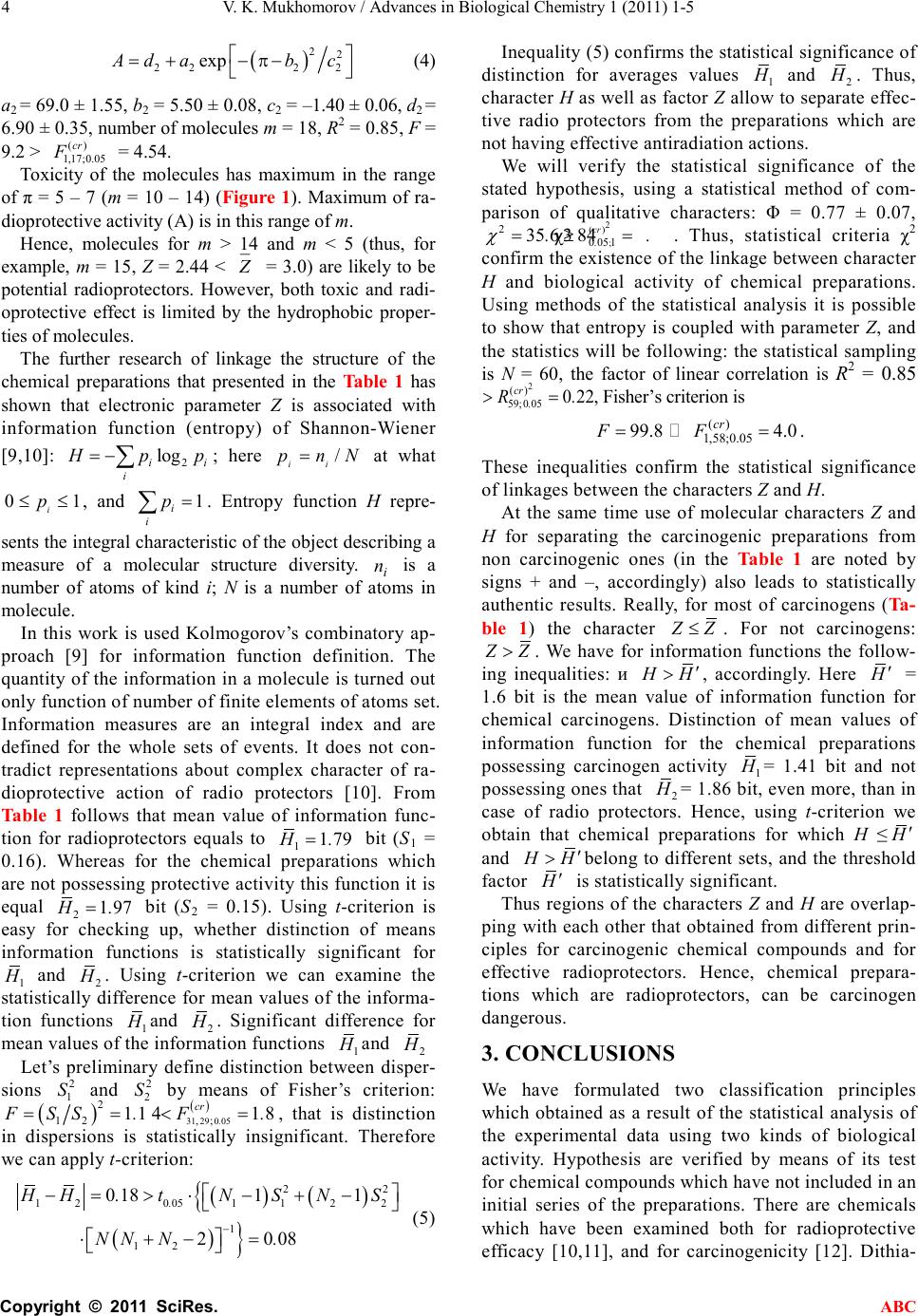
V. K . Mukhomorov / Advances in Biolo gi cal Chemistry 1 (2011) 1-5
C op yright © 2011 SciRes. ABC
( )
22
222 2
expAd abc
=+− π−
(4)
a2 = 69 .0 ± 1. 55, b2 = 5.50 ± 0.08, c2 = –1.40 ± 0.06, d2 =
6.90 ± 0.35, number of molecules m = 18, R2 = 0.85, F =
9.2 > ()
1,17;0.05
cr
F = 4.54.
Toxicity of the molecules has maximum in the range
of π = 5 – 7 (m = 10 – 14) (Figu re 1). Maxi mum of ra-
diopr otective activity (A) is in this range of m.
Hence, molecules for m > 14 and m < 5 (thus, for
example, m = 15, Z = 2.44 <
= 3.0) are likely to be
potential radioprotectors. However, both toxic and radi-
oprotective effect is limited by the hydrophobic proper-
ties of molecules.
The further research of linkage the structure of the
chemical preparations that presented in the Table 1 has
shown that electronic parameter Z is associated with
information function (entropy) of Shannon-Wiener
[9,10]: 2
log
i
= −
; here Nnp ii /= at what
, and
. Entropy function H r epre-
sents the integral characteristic of the object describi ng a
measure of a molecular structure diversity.
is a
number of atoms of kind i; N is a number of atoms in
molecule.
In this work is used Kolmogorov’s combinatory ap-
proach [9] for information function definition. The
quantity o f the infor mation in a mo lecule is turned out
onl y fu nc t ion o f n u mbe r o f fi ni te e l e me nt s o f a t o ms set.
Information measures are an integral index and are
defined for the whole sets of events. It does not con-
tradict representations about complex character of ra-
dioprotective action of radio protectors [10]. From
Ta b l e 1 follows that mean value of information func-
tion for radioprotectors equals to
bit (S1 =
0.16). Whereas for the chemical preparations which
are not po ssessin g protec tive activi ty this func tion it is
equal
bit (S2 = 0.15). Using t-criterion is
easy for checking up, whether distinction of means
information functions is statistically significant for
and
. Using t-criterion we can examine the
statisticall y difference for mean values of the informa-
tion functions
and
. Significant difference for
mean values of the information functions
and
Let’s preliminary define distinction between disper-
sio n s
and
by means of Fisher’s criterion:
( )
( )
31290 05
2
1 2,;
114 18
.
cr
F SS.F.= =<=
, that is distinction
in dispersions is statistically insignificant. Therefore
we can appl y t-c r ite r ion:
()()
( )
}
120 051122
1
12
0 1811
20 08
.
HH.tNS NS
NN N.
−
−= >⋅− +−
⋅+− =
(5)
Inequality (5) confirms the statistical significance of
distinction for averages values
and
. Thus,
character H as well as fa ctor Z allo w to separa te effec-
tive radio protectors from the preparations which are
not hav i ng e ffecti ve a ntir ad ia tio n ac tio n s.
We will verify the statistical significance of the
stated hypothesis, using a statistical method of com-
parison of qualitative characters: Φ = 0.77 ± 0.07,
2
()
;
20 051
35 6χ384
cr
.
..
χ
=≥=
. Thus, statistical criteria χ2
con firm t he exi stence of the linka ge bet ween c haracter
H and biological activity of chemical preparations.
Using methods of the statistical analysis it is possible
to show that entropy is coupled with parameter Z, and
the statistics will be followin g: the statistical sampli n g
is N = 60, the factor of linear correlation is R2 = 0.85
, Fish er’s criterion is
.
These inequalities confirm the statistical significance
of linkages between t he character s Z and H.
At the same time use of molecular characters Z and
H for separating the carcinogenic preparations from
non carcinogenic ones (in the Table 1 are noted by
signs + and –, accordingly) also leads to statistically
authentic results. Really, for most of carcinogens (Ta-
ble 1) the character
. For not carcinogens:
>. We have for information functions the follow-
ing inequalities: и
, accordingly. Here
=
1.6 bit is the mean value of information function for
chemical carcinogens. Distinction of mean values of
information function for the chemical preparations
possessing carcinogen activity
= 1.41 bit and not
posse ssi ng one s tha t 2
H= 1.86 bit, even more, than in
case of radio protectors. Hence, using t-criterion we
obtain that chemical preparations for which H ≤
and
belo ng to different sets, and the t hreshold
factor
is statis ticall y sign ifican t.
Thus regions of the characters Z and H are overlap-
ping with each other that obtained from different prin-
ciples for carcinogenic chemical compounds and for
effective radioprotectors. Hence, chemical prepara-
tions which are radioprotectors, can be carcinogen
dangerous.
3. CONCLUSIO NS
We have formulated two classification principles
which obtained as a result of the statistical analysis of
the experimental data using two kinds of biological
activity. Hypothesis are verified by means of its test
for chemical compounds which have not included in an
initial series of the preparations. There are chemicals
which have been examined both for radioprotective
efficacy [10,11], and for carcinogenicity [12]. Dithia-